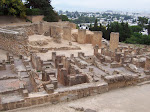Blocks and blocks in from the train station, however, you reach an arch called the Porte de France or Bab el Bahr (which in English means 'door to the sea'). There used to be an entire wall separating the modern city of Tunis from the Medina but it was broken down when the two worlds of Tunis grew closer together. The Bab el Bahr yields to a maze of souks ("markets," basically, but there isn't a sufficient English word to describe them) which form concentric circles around a central mosque. Historically, each souk had a trade associated with it. The "purer" trades like perfumes and books made up the closest souks to the mosque while less "pure" trades (tanned hides, meats, and these days electronics and plastic 'junk from Libya' as Mounir likes to say) could be found in the souks closer to the outskirts of the Medina. On my first visit to the Medina, I ate excellent rotisserie chicken with couscous and french fries (of course). The street vendors have great food, too. Another day we ate chapatis with harissa, thon (tuna) and omelette inside. I can guarantee you I remember exactly where I got them because I will be patronizing that particular chapati stand rather frequently :P From the very center of the Medina rise two minarets. One is rectangular and plain, a typical Tunisian design. The other is Turkish from when Tunisia was under Ottoman control and is more lavishly decorated. Here are pictures of both:


The best view of all of Tunis is from the rooftops of the shops in the Medina. Take a look at this view!



So are you going to publish a guide book for Tunisia when you come back to the States? Haha, everything is in great detail, why am I surprised that you managed to bring food into another blog post? :P
ReplyDeleteMy favorite picture was easily the first one in this post with the tall white building with the gold/light brown facade. Keep it up with all the great pictures :)
Great photos! The architecture is beautiful.
ReplyDelete